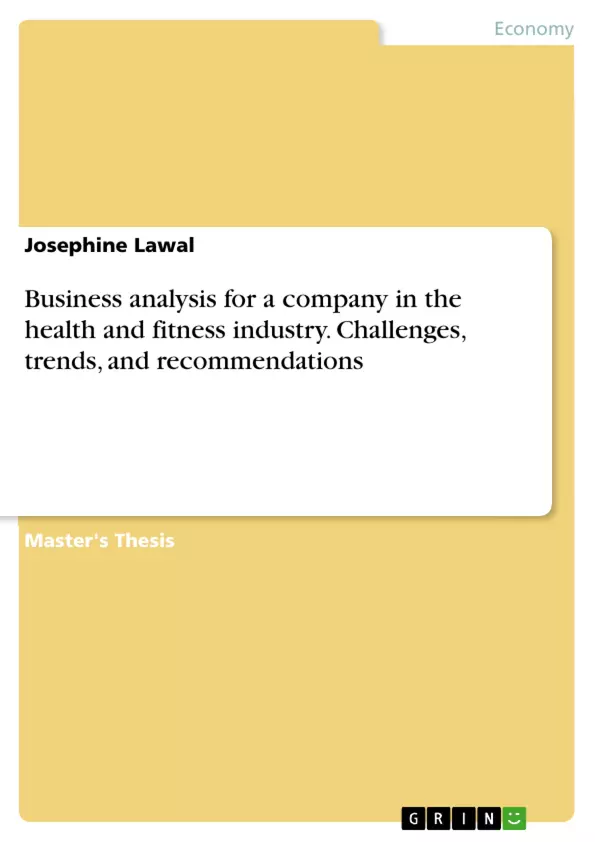This is an analysis of Harvard Business School case study: Wates Estates, a company which diversified from the traditional estate management to health and fitness industry. This analysis summarised the challenges faced by Wates Estates in the health and fitness industry. The analysis takes a look at the Wates Estate external environment and its position in the industry. It also identifies the challenges and trends in the industry and the company’s preparation to achieve the overall objective and continuous success in the health and fitness industry.
The areas of focus are strategic management, international business, direct marketing, international franchising. The analysis was conducted using several conceptual tools and models were used and justified, models such as porter five forces, swot analysis, generic competitive strategy, product life cycle model, 7S model, 7P model, PEST analysis, value chain analysis, the IT infrastructure was analysed which has a way of determining how innovative the company will be. In carrying out this research relevant questions based on the context of these areas of focus were raised to determine the effectiveness of the functional units which are a representation of the areas of focus. Findings are based on the research questions and research objectives, areas where the company is experiencing challenges are focused on and analysed, areas such as marketing, information technology infrastructure, operational efficiency, human resources effectiveness. Findings are based on the analysis to conclude where the company is now, the industry position, the market position, the international readiness and ability respond to environmental change, change management implementation plan was devised to assist the company in managing change.
Inhaltsverzeichnis (Table of Contents)
- ACKNOWLEDGEMENT
- EXECUTIVE SUMMARY
- CHAPTER ONE
- 1.0 THE CASE STUDY BRIEF
- CHAPTER TWO
- 2.0 INTRODUCTION
- 2.1 WATES ESTATES
- 2.2 ANALYTICAL MODELS
- CHAPTER THREE
- 3.0 STATEMENT OF THE PROBLEM
- 3.1 Organisational Challenges
- 3.2 CONCEPT AND FRAME WORKS FOR ANALYSIS
- CHAPTER FOUR
- 4.0 ANALYSIS USING ANALYSIS TOOLS
- 4.1 PORTER FIVE FORCES TO ANALYSIS OF WATES ESTATES
- 4.2 SWOT ANALYSIS OF CRISPINS COMPANY
- 4.3 PESTLE ANALYSIS OF WATES ESTATES
- 4.4 Human Resources Analysis using 7S frame work (Wates Estates)
- 4.5 Value Chain Analysis (Crispins)
- 4.6 Wates Levels of Strategy
- 4.7 7P Model
- 4.8 Market Analysis
- 4.9 FINDINGS
- CHAPTER FIVE
- 5.0 PROPOSED PLAN OF ACTION
- 5.1 Forecast
- 5.2 Broad Strategies for sustainability
- 5.3 CRITICAL SUCCESS FACTORS
- 5.4 OVERALL BUSINESS PLAN
- 5.5 CHANGE MANAGEMENT IMPLEMENTATION PLAN
- REFERENCES
Zielsetzung und Themenschwerpunkte (Objectives and Key Themes)
This case study examines the diversification strategy of Wates Estates, a company that transitioned from traditional estate management into the health and fitness industry. The study delves into the challenges faced by Wates Estates in this new market, analyzing its external environment and its position within the industry. The analysis aims to understand the challenges and trends in the health and fitness sector, assessing how Wates Estates prepared to achieve its objectives and maintain long-term success.
- Strategic Management
- International Business
- Direct Marketing
- International Franchising
- Change Management
Zusammenfassung der Kapitel (Chapter Summaries)
- Chapter One: Introduces the case study brief, outlining Wates Estates' history as an estate management company and its decision to invest in the health and fitness sector. It highlights the challenges faced by Crispins, a fitness club acquired by Wates Estates.
- Chapter Two: Provides an overview of Wates Estates, its business model, and the analytical models used to understand the company's situation.
- Chapter Three: Identifies the problems and challenges faced by Wates Estates within the health and fitness industry. This chapter discusses the organizational challenges and the conceptual frameworks used for analysis.
- Chapter Four: Utilizes various analytical tools to analyze Wates Estates' position within the industry. These tools include Porter's Five Forces, SWOT analysis, PESTLE analysis, 7S framework, value chain analysis, and the 7P model.
Schlüsselwörter (Keywords)
The case study focuses on strategic management, international business, direct marketing, international franchising, and change management within the context of the health and fitness industry. It employs various analytical models such as Porter's Five Forces, SWOT analysis, PESTLE analysis, 7S framework, value chain analysis, and the 7P model to analyze the challenges and opportunities of Wates Estates in this new market. The analysis examines key aspects like the company's market position, international readiness, and its ability to respond to environmental changes. The study also explores change management implementation plans to assist the company in managing the transition process.
- Quote paper
- Josephine Lawal (Author), 2012, Business analysis for a company in the health and fitness industry. Challenges, trends, and recommendations, Munich, GRIN Verlag, https://www.grin.com/document/1294310



